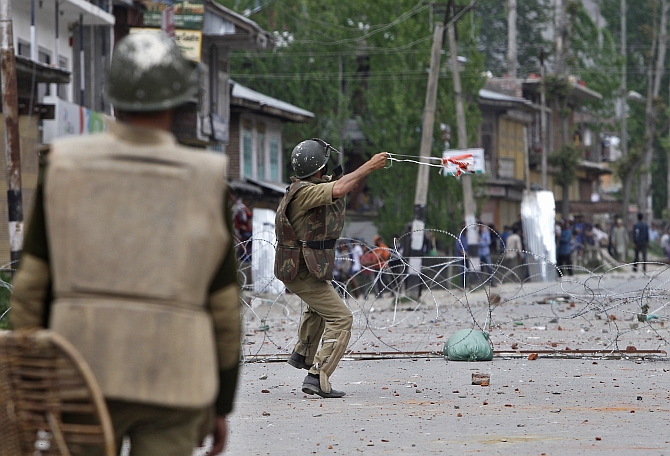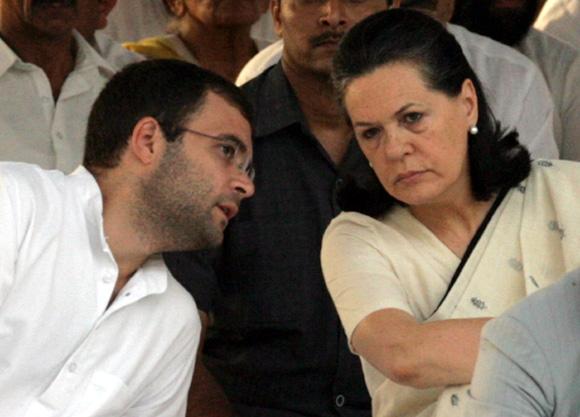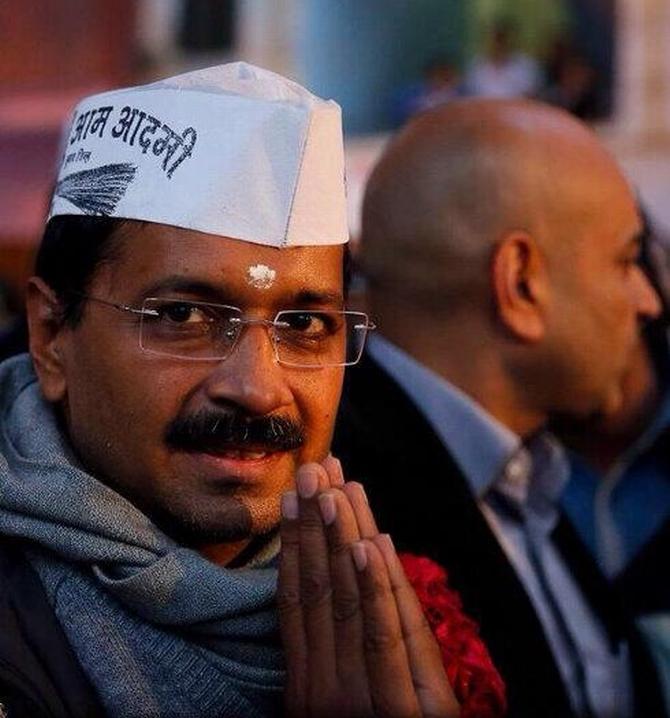Photographs: Adnan Abidi/Reuters Bharat Bhushan
The Bharatiya Janata Party will continue to have a rightward tilt. So, challenging neo-liberal economic policies will be key to the formation of a Centre-Left Opposition, which could happen in two to three years
The clear mandate given by the voters to the Bharatiya Janata Party and the decimation of all other political parties, except a few regional ones, have shrunk the oppositional space in Indian politics. That space will be increasingly transformed by the policies that the BJP will follow over the next five years. It is interesting to imagine how it might be shaped and who could occupy it.
Under Narendra Modi, the BJP will undoubtedly move towards the Centre. This has been clear from his campaign pronouncements. The compulsions of good governance will also provide a push towards centrist politics.
However, the BJP will continue to have a rightward tilt. The rightward push is likely to come from two forces -- the party's neo-liberal economic agenda and it's Hindutva antecedents. The corporations that promoted Modi's election want the quick implementation of a growth agenda, based on deregulation and liberalisation. They will push for government-facilitated corporate access to public resources -- land, forests, water, and minerals -- and opening up or further liberalisation of investment rules in insurance and other sectors.
Already, the ministry of environment and forests has reportedly been told to hasten clearances for pending projects and there is talk of opening up the insurance sector to allow foreign direct investment up to 49 per cent and 100 per cent FDI in the defence production sector. The middle-class beneficiaries of economic liberalisation will also push for a rightward shift in economic policies.
Opposition to neo-liberal economic policies then, will undoubtedly be central to the formation of a Centre-Left oppositional space. This may not happen in two to three months' time, but it could well happen in two to three years.
A rightward ideological push will also come from the Hindutva family of organisations. They see the BJP's parliamentary victory as a singular opportunity to press for initiatives that advance their "cultural" agenda, which had to be attenuated under coalition compulsions between 1998 and 2004. The Rashtriya Swayamsevak Sangh did not pull out all stops to get a BJP government elected to implement an ideologically neutral agenda.
…
The Hindutva agenda will agitate the already angry Kashmiris
Image: A policeman throws a stone towards Kashmiri protesters during an anti-election protest in Baramulla district, north of SrinagarPhotographs: Danish Ismail/Reuters
Some of the core issues, such as the abrogation of Article 370 of the Constitution, implementing a uniform civil code and building a Ram Temple at Ayodhya, that define their idea of India have already been publicly articulated by ministers. The more debates are organised around these contentious issues, the more social cleavages will open up. These issues might be left to the fag end of the tenure of this government. A polarisation at that point could once again help the party electorally in the 2019 general elections.
The economic agenda then has the potential to trigger local peoples' movements for control over natural resources, forced eviction or environmental aspects of big projects. The Hindutva agenda, on the other hand, will agitate the already angry Kashmiris and the minority communities -- for, besides Muslims, the uniform civil code also applies to tribals and others whose personal law is currently constitutionally protected.
People would be forced to take positions on the necessity of retaining Article 370, amending the Constitution to have a uniform civil code, which would certainly benefit women, and the Ram Temple. Taking a position, one way or the other, will not be easy for the non-BJP political parties. Nonetheless, the oppositional political space would potentially get enlarged.
…
No political party will join hands with the Congress
Image: Congress Vice President Rahul Gandhi with his mother and party chief SoniaEven as the oppositional platform evolves, it is doubtful whether the Congress would be able to occupy this space. Nor would the Aam Aadmi Party fit the bill.
The Congress is likely to slide further in the coming state assembly elections. It is unlikely to crystallise larger national forces around it. No political party is going to join hands with it for the sole purpose of crowning a Nehru-Gandhi family member.
As for the AAP, the earlier hope that it would occupy the space being vacated by the Congress has imploded. Arvind Kejriwal's equation of himself with the aspirations of the common man -- or his "I, the people" approach -- has been the undoing of his politics. If he continues to project himself as the chief ministerial candidate of Delhi, then the ensuing state assembly polls may prove to be the last gasp of the potential AAP represented. The voters seldom give a second chance to maverick politicians.
While there is no dearth of NGOs, peoples' movements or public intellectuals who might occupy the oppositional platform, it is harder to see the mechanisms for mobilising people behind the issues that the platform represents. To effectively mobilise public support, a political party or several political parties working in concert would be required.
...
Voters seldom give a second chance to maverick politicians
Image: AAP chief Arvind KejriwalPossible candidates for joining this platform would be several parties and emergent political formations, and movements opposed to the BJP's economic policies and Hindutva agenda. However, they would have to merge their identities in a way that seems unthinkable as of now.
The most important precondition for such a merged formation would be that the leadership question should be left open. This formation or political party would be the natural political home for the most backward castes, Muslims, tribals, the Dalits as well as the dominant upper castes - because there is no social conflict between these groups.
On the other hand, the BJP in the coming years is likely to become a party led by the Other Backward Castes. To some extent, this is already happening in Uttar Pradesh and Bihar. This would also be a compulsion if the party wants to continue to do well in northern India.
There could then be large-scale desertions from the dominant OBCs from their traditional parties -- personified by family-owned parties such as the Samajwadi Party and the Rashtriya Janata Dal -- as they seek merit-based opportunities in the BJP. These parties could become virtually extinct and their weakened rumps would find it difficult to join the Centre-Left platform because of inherent caste contradictions with its other supporters.
The first indication of whether the non-BJP parties are thinking strategically would come from the alliances formed in the state assembly election due in Bihar in 2015 and in Uttar Pradesh in 2016.






article